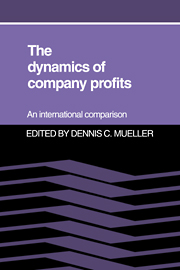Book contents
- Frontmatter
- Contents
- Preface
- Contributors
- 1 Profits and the process of competition
- 2 Modeling persistent profitability
- 3 The persistence of profits in the United States
- 4 The persistence of profits in U.S. manufacturing industries
- 5 The persistence of profitability in Canada
- 6 The persistence of corporate profits in the Federal Republic of Germany
- 7 The persistence of profits in France
- 8 The persistence of profits in Japan
- 9 The persistence of profits in the United Kingdom
- 10 The persistence of profits: international comparison
- 11 The persistence of profits in perspective
- References
- Index
7 - The persistence of profits in France
Published online by Cambridge University Press: 03 May 2010
- Frontmatter
- Contents
- Preface
- Contributors
- 1 Profits and the process of competition
- 2 Modeling persistent profitability
- 3 The persistence of profits in the United States
- 4 The persistence of profits in U.S. manufacturing industries
- 5 The persistence of profitability in Canada
- 6 The persistence of corporate profits in the Federal Republic of Germany
- 7 The persistence of profits in France
- 8 The persistence of profits in Japan
- 9 The persistence of profits in the United Kingdom
- 10 The persistence of profits: international comparison
- 11 The persistence of profits in perspective
- References
- Index
Summary
The sample consists of all firms for which data were available over the entire period under review (1965–82). These included all firms listed on the stock exchange or subject to the legal obligation to publish financial statements. Although the number of firms subject to this legal obligation in 1965 was close to a thousand, a number of them were merged, liquidated, or transformed into holding companies during the period under review. Some were also not legally obligated to publish data in every year. Thus, our sample consists of 450 firms (see Table 7.1).
The profit rate variable is defined as follows: (profit before taxes + interest payments)/total assets. Although it would have been preferable to use after tax profits, the amount of taxes paid by the firms was not available. One should note that in previous structure performance studies in France, the same profit rate definition was used and the econometric results were consistent with those of other countries and what standard theories predict.
The average profit rates of the 450 firms in the sample and the dispersion of profit rates varied over time, as can be seen from Table 7.2. The 18-year interval can be subdivided into four periods: profit stability from 1965 through 1968; high average profit rates from 1969 through 1973, which was one of sustained growth in France; a period of profit rate instability (1974–80) reflecting adjustment to the oil crisis; and a decline in profits in 1981 and 1982, possibly due to the measures taken by the socialist government that came into power in 1981 but also to stiffening competition among firms in a period of declining growth.
- Type
- Chapter
- Information
- The Dynamics of Company Profits , pp. 123 - 128Publisher: Cambridge University PressPrint publication year: 1990
- 8
- Cited by



